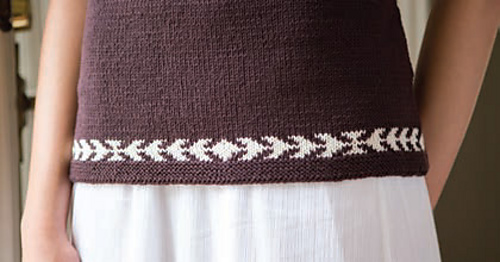patterns > Piecework >  The Unofficial Downton Abbey Knits 2014 and 1 more...
The Unofficial Downton Abbey Knits 2014 and 1 more...
> Cosmopolitan Peasant Blouse




Cosmopolitan Peasant Blouse
Interweave SKU: EP11496
Knit this sweater inspired by a garment in the Columbia Yarn Book from 1923 Featuring a front center motif with repeated visual elements on the sleeve hem and shirt hem, this sweater is worked separate pieces and seamed. (Interweave)
Charts and Schematics can be found here.
Finished Size: 37½ (41, 43) inches (95.2 [104.1, 109.2] cm) bust circumference
Yarn: Rowan Wool Cotton, 50% merino wool/50% cotton, DK weight, 123 yards (112.5 m)/50 gram (1.8 oz) ball, 8 (9, 9) balls of #956 Coffee Rich (MC) and 1 ball of #900 Antique (CC)
Yarn Weight: #3 - Light
Needles: Circular, 24 inches (60 cm) size 4 (3.25 mm) for edgings and size 5 (3.75 mm) for body and sleeves or size needed to obtain gauge
Notions: Crochet hook size E/4 (3.5 mm); stitch markers; stitch holders; tapestry needle
Gauge: 22½ sts and 32 rows = 4 inches (10.2 cm) in St st on larger needles
Originally Published: Unofficial Downton Abbey Knits 2014
I adapted this Peasant Blouse from a knitted garment in a 1923 Columbia Yarn Book. The original garment was knitted up the back, over the shoulders, and down the front, eliminating shoulder seams. The border on the short cap sleeves repeats the bottom border. I chose to knit both the back and the front from the bottom up so that all pattern stitches, cast-on edges, and shaping match. I grafted the shoulder tops together to eliminate shoulder seams. The slightly shaped garment will flatter most figures, and the wool-and-cotton yarn will be comfortable except in the hottest weather.
In the Columbia book, only one size is provided, and the knitter was on her or his own to alter sizes, aided only by brief general suggestions at the back of the book: “One of the features which many workers consider a quite insuperable obstacle is that of changing sizes. In reality it is the simplest possible operation if a few plain instructions are carefully followed.” These introduce the concept of gauge and measurements with examples that made me grateful for the information and sizing found in today’s publications.
9892 projects
stashed
8038 times
- First published: September 2014
- Page created: September 22, 2014
- Last updated: January 14, 2023 …
- visits in the last 24 hours
- visitors right now

